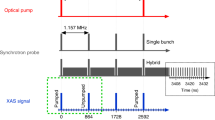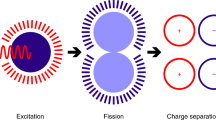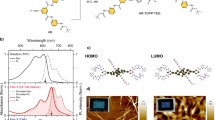Abstract
Exciton fission is a process that occurs in certain organic materials whereby one singlet exciton splits into two independent triplets. In photovoltaic devices these two triplet excitons can each generate an electron, producing quantum yields per photon of >100% and potentially enabling single-junction power efficiencies above 40%. Here, we measure fission dynamics using ultrafast photoinduced absorption and present a first-principles expression that successfully reproduces the fission rate in materials with vastly different structures. Fission is non-adiabatic and Marcus-like in weakly interacting systems, becoming adiabatic and coupling-independent at larger interaction strengths. In neat films, we demonstrate fission yields near unity even when monomers are separated by >5 Å. For efficient solar cells, however, we show that fission must outcompete charge generation from the singlet exciton. This work lays the foundation for tailoring molecular properties like solubility and energy level alignment while maintaining the high fission yield required for photovoltaic applications.
This is a preview of subscription content, access via your institution
Access options
Subscribe to this journal
Receive 12 print issues and online access
$259.00 per year
only $21.58 per issue
Buy this article
- Purchase on Springer Link
- Instant access to full article PDF
Prices may be subject to local taxes which are calculated during checkout




Similar content being viewed by others
Change history
21 May 2014
In the version of this Article originally published, the author name Moungi G. Bawendi was missing the middle initial. This has now been corrected in the online versions of the Article.
References
Geacintov, N., Pope, M. & Vogel, F. Effect of magnetic field on the fluorescence of tetracene crystals: exciton fission. Phys. Rev. Lett. 22, 593–596 (1969).
Congreve, D. N. et al. External quantum efficiency above 100% in a singlet-exciton-fission-based organic photovoltaic cell. Science 340, 334–337 (2013).
Hanna, M. C. & Nozik, A. J. Solar conversion efficiency of photovoltaic and photoelectrolysis cells with carrier multiplication absorbers. J. Appl. Phys. 100, 074510 (2006).
Smith, M. B. & Michl, J. Singlet fission. Chem. Rev. 110, 6891–6936 (2010).
Chan, W-L. et al. Observing the multiexciton state in singlet fission and ensuing ultrafast multielectron transfer. Science 334, 1541–1545 (2011).
Lee, J. et al. Singlet exciton fission in a hexacene derivative. Adv. Mater. 25, 1445–1448 (2013).
Lee, J., Jadhav, P. & Baldo, M. A. High efficiency organic multilayer photodetectors based on singlet exciton fission. Appl. Phys. Lett. 95, 033301 (2009).
Wilson, M. W. B. et al. Ultrafast dynamics of exciton fission in polycrystalline pentacene. J. Am. Chem. Soc. 133, 11830–11833 (2011).
Burdett, J. J. & Bardeen, C. J. Quantum beats in crystalline tetracene delayed fluorescence due to triplet pair coherences produced by direct singlet fission. J. Am. Chem. Soc. 134, 8597–8607 (2012).
Johnson, J. C., Nozik, A. J. & Michl, J. High triplet yield from singlet fission in a thin film of 1,3-diphenylisobenzofuran. J. Am. Chem. Soc. 132, 16302–16303 (2010).
Gradinaru, C. C. et al. An unusual pathway of excitation energy deactivation in carotenoids: singlet-to-triplet conversion on an ultrafast timescale in a photosynthetic antenna. Proc. Natl Acad. Sci. USA 98, 2364–2369 (2001).
Zimmerman, P. M., Zhang, Z. & Musgrave, C. B. Singlet fission in pentacene through multi-exciton quantum states. Nature Chem. 2, 648–652 (2010).
Englman, R. & Jortner, J. The energy gap law for radiationless transitions in large molecules. Mol. Phys. 18, 145–164 (1970).
Greyson, E. C., Vura-Weis, J., Michl, J. & Ratner, M. A. Maximizing singlet fission in organic dimers: theoretical investigation of triplet yield in the regime of localized excitation and fast coherent electron transfer. J. Phys. Chem. B 114, 14168–14177 (2010).
Beljonne, D., Yamagata, H., Brédas, J. L., Spano, F. C. & Olivier, Y. Charge-transfer excitations steer the Davydov splitting and mediate singlet exciton fission in pentacene. Phys. Rev. Lett. 110, 226402 (2013).
Berkelbach, T. C., Hybertsen, M. S. & Reichman, D. R. Microscopic theory of singlet exciton fission. II. Application to pentacene dimers and the role of superexchange. J. Chem. Phys. 138, 114103 (2013).
Johnson, J. C., Nozik, A. J. & Michl, J. The role of chromophore coupling in singlet fission. Acc. Chem. Res. 46, 1290–1299 (2013).
Chan, W-L., Ligges, M. & Zhu, X. Y. The energy barrier in singlet fission can be overcome through coherent coupling and entropic gain. Nature Chem. 4, 840–845 (2012).
Wu, Q., Cheng, C. L. & Van Voorhis, T . Configuration interaction based on constrained density functional theory: a multireference method. J. Chem. Phys. 127, 164119 (2007).
Feng, X., Luzanov, A. & Krylov, A. I. Fission of entangled spins: an electronic structure perspective. J. Phys. Chem. Lett. 4, 3845–3852 (2013).
Yost, S. R., Hontz, E., Yeganeh, S. & Van Voorhis, T. Triplet versus singlet energy transfer in organic semiconductors: the tortoise and the hare. J. Phys. Chem. C 116, 17369–17377 (2012).
Zimmerman, P. M., Bell, F., Casanova, D. & Head-Gordon, M. Mechanism for singlet fission in pentacene and tetracene: from single exciton to two triplets. J. Am. Chem. Soc. 133, 19944–19952 (2011).
Berkelbach, T. C., Hybertsen, M. S. & Reichman, D. R. Microscopic theory of singlet exciton fission. I. General formulation. J. Chem. Phys. 138, 114102 (2013).
Casanova, D. Electronic structure study of singlet fission in tetracene derivatives. J. Chem. Theory Comput. ASAP 10, 324–334 (2014).
Renaud, N., Sherratt, P. A. & Ratner, M. A. Mapping the relation between stacking geometries and singlet fission yield in a class of organic crystals. J. Phys. Chem. Lett. 4, 1065–1069 (2013).
Dreuw, A. & Head-Gordon, M. Single-reference ab initio methods for the calculation of excited states of large molecules. Chem. Rev. 105, 4009–4037 (2005).
Kaduk, B., Kowalczyk, T. & Van Voorhis, T . Constrained density functional theory. Chem. Rev. 112, 321–370 (2011).
Yamagata, H. et al. The nature of singlet excitons in oligoacene molecular crystals. J. Chem. Phys. 134, 204703 (2011).
Tiago, M. L., Northrup, J. E. & Louie, S. G. Ab initio calculation of the electronic and optical properties of solid pentacene. Phys. Rev. B 67, 115212 (2003).
Sharifzadeh, S., Darancet, P., Kronik, L. & Neaton, J. B. Low-energy charge-transfer excitons in organic solids from first-principles: the case of pentacene. J. Phys. Chem. Lett. 4, 2197–2201 (2013).
Jortner, J. & Bixon, M. Intramolecular vibrational excitations accompanying solvent-controlled electron transfer reactions. J. Chem. Phys. 88, 167–170 (1988).
Sparpaglione, M. & Mukamel, S. Adiabatic vs. nonadiabatic electron transfer and longitudinal solvent dielectric relaxation: beyond the Debye model. J. Phys. Chem. 91, 3938–3943 (1987).
Marcus, R. On the theory of oxidation—reduction reactions involving electron transfer. I. J. Chem. Phys. 24, 966–978 (1956).
Piland, G. B., Burdett, J. J., Kurunthu, D. & Bardeen, C. J. Magnetic field effects on singlet fission and fluorescence decay dynamics in amorphous rubrene. J. Phys. Chem. C 117, 1224–1236 (2012).
Thorsmølle, V. K. et al. Morphology effectively controls singlet–triplet exciton relaxation and charge transport in organic semiconductors. Phys. Rev. Lett. 102, 017401 (2009).
Burdett, J. J. & Bardeen, C. J. The dynamics of singlet fission in crystalline tetracene and covalent analogs. Acc. Chem. Res. 46, 1312–1320 (2013).
Anthony, J. E., Brooks, J. S., Eaton, D. L. & Parkin, S. R. Functionalized pentacene: improved electronic properties from control of solid-state order. J. Am. Chem. Soc. 123, 9482–9483 (2001).
Miao, Q. et al. Organization of acenes with a cruciform assembly motif. J. Am. Chem. Soc. 128, 1340–1345 (2006).
Purushothaman, B., Parkin, S. R. & Anthony, J. E. Synthesis and stability of soluble hexacenes. Org. Lett. 12, 2060–2063 (2010).
Bulgarovskaya, I., Vozzhennikov, V. & Aleksandrov, S. V. Belsky in Latv. PSR Zinat. Akad. Vestis Fiz. Teh. Zinat. Ser 4, 53 (1983).
Holmes, D., Kumaraswamy, S., Matzger, A. J. & Vollhardt, K. P. C. On the nature of nonplanarity in the [N]phenylenes. Chem. Eur. J. 5, 3399–3412 (1999).
Ruiz, R. et al. Structure of pentacene thin films. Appl. Phys. Lett. 85, 4926–4928 (2004).
Manzoni, C., Polli, D. & Cerullo, G. Two-color pump–probe system broadly tunable over the visible and the near infrared with sub-30 fs temporal resolution. Rev. Sci. Instrum. 77, 023103 (2006).
Wu, Q. & Van Voorhis, T. Direct calculation of electron transfer parameters through constrained density functional theory. J. Phys. Chem. A 110, 9212–9218 (2006).
Woodcock, H. L. et al. Interfacing Q-Chem and CHARMM to perform QM/MM reaction path calculations. J. Comput. Chem. 28, 1485–1502 (2007).
Nelsen, S. F., Blackstock, S. C. & Kim, Y. Estimation of inner shell Marcus terms for amino nitrogen compounds by molecular orbital calculations. J. Am. Chem. Soc. 109, 677–682 (1987).
Peumans, P., Yakimov, A. & Forrest, S. R. Small molecular weight organic thin-film photodetectors and solar cells. J. Appl. Phys. 93, 3693–3723 (2003).
Nitsche, R. & Fritz, T. Determination of model-free Kramers–Kronig consistent optical constants of thin absorbing films from just one spectral measurement: application to organic semiconductors. Phys. Rev. B 70, 195432 (2004).
Acknowledgements
This work was supported as part of the Center for Excitonics, an Energy Frontier Research Center funded by the US Department of Energy, Office of Science, Office of Basic Energy Sciences (award no. DE-SC0001088, MIT). The measurements on pentacene, TIPS-P and DTP were supported by the Engineering and Physical Sciences Research Council. A.R. thanks Corpus Christi College, Cambridge, for a research fellowship. Research was carried out in part at the Center for Functional Nanomaterials, Brookhaven National Laboratory, which is supported by the US Department of Energy, Office of Basic Energy Sciences (contract no. DE-AC02-98CH10886). The authors thank E. Hontz for discussions, C. Hanson for assistance with spectroscopy and B. Fernandez, T. L. Andrew and L. Liufor help with sample preparation and crystallization.
Author information
Authors and Affiliations
Contributions
T.V.V., M.A.B., J.Y., M.W.B.W. and S.R.Y. designed the experiment and co-wrote the paper. S.R.Y. and D.P.M. performed the density functional theory calculations. J.L., M.W.B.W., A.R., K.J. and M.Y.S. performed the spectroscopy. R.R.P. contributed material synthesis. T.W., N.J.T. and D.N.C. characterized the solar cells. All authors discussed the results and commented on the manuscript.
Corresponding authors
Ethics declarations
Competing interests
The authors declare no competing financial interests.
Supplementary information
Supplementary information
Supplementary information (PDF 1219 kb)
Supplementary information
Crystallographic data for compound DBP (CIF 20 kb)
Supplementary information
Crystallographic data for compound DBTP (CIF 16 kb)
Supplementary information
Crystallographic data for compound DTT (CIF 17 kb)
Rights and permissions
About this article
Cite this article
Yost, S., Lee, J., Wilson, M. et al. A transferable model for singlet-fission kinetics. Nature Chem 6, 492–497 (2014). https://doi.org/10.1038/nchem.1945
Received:
Accepted:
Published:
Issue Date:
DOI: https://doi.org/10.1038/nchem.1945
This article is cited by
-
A framework for multiexcitonic logic
Nature Reviews Chemistry (2024)
-
Orbital-resolved observation of singlet fission
Nature (2023)
-
Parallel triplet formation pathways in a singlet fission material
Nature Communications (2022)
-
Free-triplet generation with improved efficiency in tetracene oligomers through spatially separated triplet pair states
Nature Chemistry (2021)
-
Open questions on the photophysics of ultrafast singlet fission
Communications Chemistry (2021)



